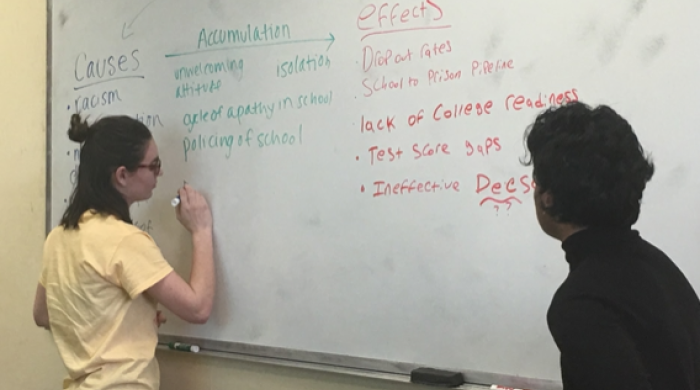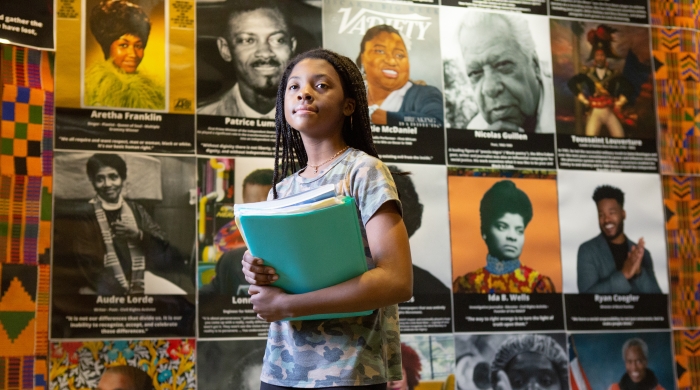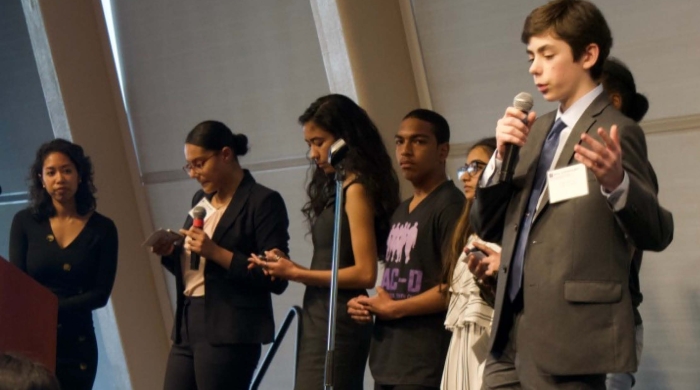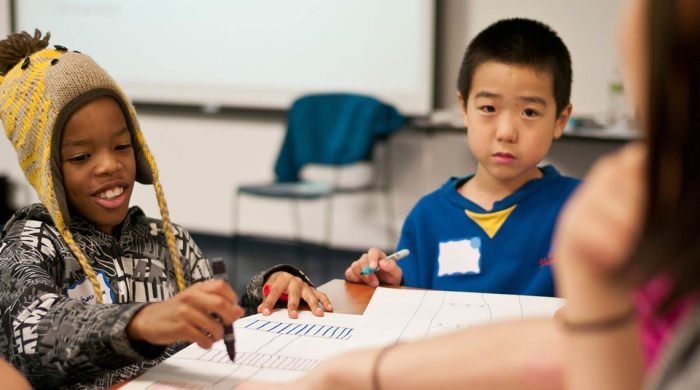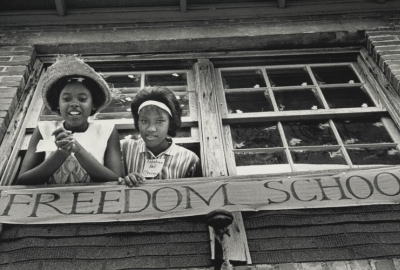

Before taking action to address disproportionality (such as shifting policies and practices) with adult allies and the greater community, it is necessary to invest the time to learn about current issues and their deep historical root causes. Of course, education is never neutral (c.f. Henry Giroux) what educators teach in school are inherently political decisions. Too often, an exploration around power and privilege is left out of the classroom. Given that schooling outcomes are raced and classed it was necessary for YTAC-D to first implement an unapologetic anti-racist, critical, and humanizing curriculum. Together, we addressed a broad range of issues surrounding education and its sociopolitical historical context. Further, in the planning stages, topics were driven by youth, with the support of a well-informed and trained adult on topics of equity and justice.
In our first few sessions, we defined the terms equality, equity, fairness, opportunity, and access as related to the political context of the education system. We also made sure to define the terms race, class, culture, ethnicity and how these terms differ and intersect (for definitions, view Appendix A). In discussing these terms we discussed how “colorblind” (more accurately termed color evasive c.f Subini Annamana) policies are detrimental to students of color and upholds white privilege. In addition to those terms and their implications, we also learned about the school to prison pipeline and discussed events related to disproportionality such as the Black student who was thrown in her desk by a white police officer at Spring Valley High School in South Carolina. Facilitators used several real world examples and current events to help illuminate the root causes of disproportionality. These examples often spurred rich dialogue where students added their own experiences that helped deepen understandings.
Furthermore, we read and discussed several articles surrounding disproportionality that were released during our time together. From January 2018 through June 2019 we discussed several current events that came up organically. With the understanding that current events have a historical and political context, we discussed pressing issues and the factors that brought these issues to the fore, along with its implications. We discussed how Betsy Devos and Trump’s administration worked to repeal some of the progressive discipline policies recommended by the Obama administration. For instance, Trump supported punitive discipline policies that suspend students supposedly for school safety purposes, in order to prevent mass shootings, such as the Parkland incident. Yet, YTAC-D students disagreed with such policies and statements and came up with counterarguments as a group. For instance, YTAC-D’s counterarguments cited that these school shootings have been at predominately white schools, and that the shooters have been suspended before and that did not stop them from committing murder in schools. Many YTAC-D students held leadership roles in the school walkouts, and we held discussions on how different school leaders responded to the walkouts. The predominantly Black schools were discouraged from walking out, while the predominately white schools were encouraged and teachers walked with them. White students were allowed to express their dissent while Black students were discouraged and punished for protesting. This is part of a larger phenomenon where white people are encouraged to challenge authority structures because their concerns are assumed to be valid, whereas BIPOC[1] youth must prove that their grievances are systemic and not individual, showing a double standard between white and BIPOC students. These conversations and exploration of current events related to educational equity gave YTAC-D members extra context to deepen their understanding of how disproportionality exists in schools. For an example of a meeting agenda, view Appendix B.
YTAC-D was a place where we learned about ourselves as well as each other.
Marginalized students often undergo years of gaslighting where we are told that our experiences are our own faults rather than symptoms of systems of oppression that have predated us by years as well as a shared experience. In being told this lie about a singular experience, we undergo years of self-hatred and self-blame. We are encouraged- by our authority figures and by ourselves- to do everything in our power to conform to standards that were made to alienate us. It is impossible. It is easy to lose yourself in that constant struggle of self-deprecation and conformity. By simply exposing the roots and reverberations of our experiences through historical, social, and political education this group allowed us to begin to unravel the web of white lies. We were given the space to process that emotionally and were supported by each other in our group meetings. We were not expected to put our feelings into our work in order to produce-there was a healthy balance between work, education, and emotional healing which is something that is often lost in youth activism groups. All of our emotions around the violence that had been done onto us via the gaslighting were validated and we were allowed the capacity to process all the implications of this violence.
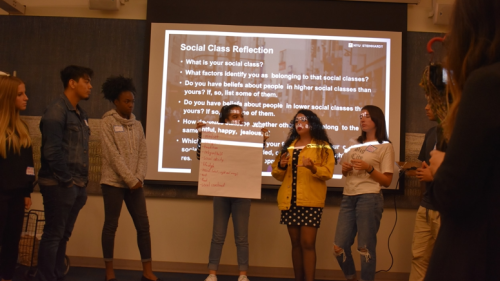
Other topics that we discussed extensively were:
- 2018 Government Accountability Report
- College Admissions Scandal
- Specialized High School Controversy
- Tracking
- White Professor Calls Police on Black Student
- Policing and mass incarceration
- New York State’s Suspension Crisis
- Asian American & Affirmative Action Case
- Model minority myth
To deepen our knowledge about current issues we had political education on concepts such as
- Class vs. Race
- Intersectionality
- Redlining and the legacy of racialized housing discrimination and segregation
- School to prison pipeline
- Suspension disparities across the city
- Examined local, state and national education data
The American education system was not made for me. Being an AfroLatinx, Queer, and Non-Binary person, I am used to being othered in the classroom setting. I was only ever able to see myself once a year, in February. My personal schooling experience has been one of being Ostracized and alienated not just by the curriculum but also the policies and which administrators enforced. I always thought to myself that we need to re-imagine what education looks like and feels like. It shouldn't be a replica of the carceral state, it shouldn't uphold whiteness and white superiority, it shouldn't uphold cis heteropatriarchy, it shouldn't manifest violence in all its many forms. I never had the language to describe my experience with the school-to-prison pipeline or even the school to military pipeline. Both pipelines are very deliberate manifestations, tools of white supremacy. It was in YTACD that I first learned about the term disproportionality. It was easy to dissect because all I had to do was related to my lived experience. all of the readings and the data dives, all of the research helps a firm but I had already known. Being in that space was authentic and healing even. I had already been involved in organizing work prior, but Y-Tacd played an integral role in my Community Building and interpersonal building. Now entering my sophomore year of college, as a first-gen college student, I still utilize all that I learned in that space. It was the naturally forming community aspect of YTACD that I enjoyed prior to my departure, and something I wish to see it continue to embody moving forward.
(Re)Defining Disproportionality

As part of our political education, we redefined the term “disproportionality.” As a result of our historical political exploration of disproportionality our group felt it necessary to revise the US Department of Education’s definition of disproportionality, as it was insufficient to its actual meaning. Together, the students worked together to chart out the root causes and outcomes of disproportionality (see Figure 3). After several attempts to get it “right”, the YTAC-D defined disproportionality as “the outcome of institutionalized racism and bias that result in discriminatory beliefs, policies, and practices, which negatively affect historically marginalized groups in contrast to privileged groups”
Political education was a foundational and ongoing part of this work. The YTAC-D curriculum set us up to pursue our participatory action research project.
[1] Black, Indigenous, People of Color

